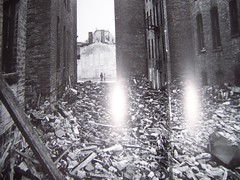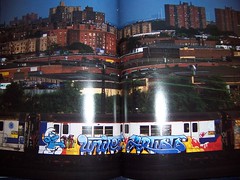1977 (Two Sevens Clash)

A good friend from Brazil was just in town for a visit. He'd spent his high school years in NYC (his dad was a diplomat), and we went to college together at Fordham in Lincoln Center -- we became friends working at the school paper, The Observer. In the late 90s, he moved back to Sao Paulo, but he often visits once or twice a year. Even though he has a really sweet life down in Brazil, you could tell that a good part of him still missed the Big Apple. Except this time. We were talking about how New York has changed -- and not for the better. We bitched about how expensive rents have become, how all the chain stores have forced out all the local mom and pop shops, how so many neighborhoods have lost their distinctiveness as the developers have run wild in every borderline neighborhood left in Manhattan (below 96th Street, of course). He said New York has lost its "grittiness." And he mentioned that this time, he doesn't really miss living here like he used to. And that's just sad.
I just picked up this book called "Ladies and Gentlemen, The Bronx is Burning," which details a particularly bi-polar year in the life of New York City (1977: think Son of Sam, the blackout rioting, block after block in the South Bronx being torched for insurance money vs. Reggie Jackson and the Yankees winning the World Series, the ascendant disco era at Studio 54 and the burgeoning punk rock scene on the Bowery). I was 11 at the time and going to a boarding school in Manhattan (another story entirely), and remember a fair amount of that year (the Son of Sam lived and was caught in Yonkers, just a few neighborhoods over from ours; I was in the stands to witness Reggie wack several balls out of the stadium in the lead-up to the pennant; and my middle school advisor had a clump of Yankee Stadium grass in a glass tube from game 6 of the World Series when fans tore up the joint). And I'm feeling nostalgic for a New York City that was grimy, thrilling and a bit menacing, when artists actually lived in Soho and walking on 9th Avenue in Hell's Kitchen or past Avenue A in the East Village alone at night was asking for trouble.
Sheep Meadow was an ungated dust bowl that hosted every sport imaginable on a warm, sunny day. The sidewalks of every residential neighborhood in Manhattan were a minefield of dog poop. You kept your head down not to avoid eye contact, but to keep your shoes clean. Every surface on the inside of a subway car was tagged in black magic marker, a massive swirl of oppressiveness -- but if you were lucky, a train would pull in the station that had a car or two that sported giant cartoon characters and neon lettering on its skin. These train yard masters produced incredibly beautiful art for a city so down on its heels. And it seemed so appropriate that the elevated tracks ran through some of the ugliest and meanest parts of town, so the trains could bring some color and life and art to where there was often very little.

New York City wasn't for everyone, but it was real and chaotic and exciting. Now most of Manhattan is a romper room for the young, rich and fabulous, and Times Square is just a flashier version of a thousand other malls to make the out-of-towners feel at home, and not much is left in-between. I know that everything is always changing and always will, and I hate sounding like an old coot hanging round the barbershop talking down to the whippersnappers about how good things were in the old days, but my city is gone and I miss it so.
(The subway photo comes from the amazing book "Subway Art" by Martha Cooper and Henry Chalfant, while the shot of the South Bronx was taken from "In the South Bronx of America" by Mel Rosenthal.)

0 Comments:
Post a Comment
<< Home